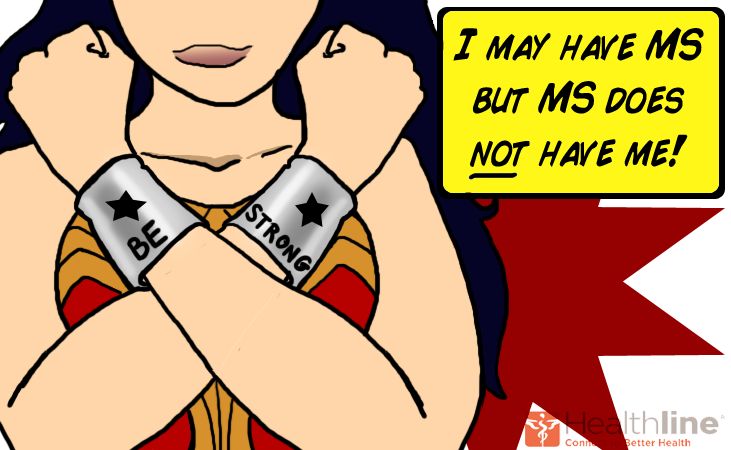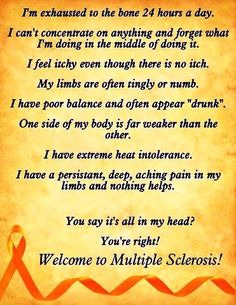
March is MS Awareness Month
So, what does that really mean?
On the other side of MS, I was “aware” that MS existed. I was “aware” that people had it.
That’s about all I was “aware” of.
On this side of MS, I’d like to say that I’d rather not be “aware” of it.
Yeah, yeah. I know burying my head in the sand isn’t going to accomplish anything … but … sometimes it’s a relief to not think about IT.
Many of you probably didn’t know anyone with MS, until my diagnosis. Chances are I may be the only one you know with it.
I’d like to share just a little bit about MS with you.
What is MS?
Me:
MS is a disease that will turn your world upside down.
Activities such as showering and dressing are exhausting and take much longer to accomplish than before.
Official:
MS is a chronic disease that damages the nerves in the spinal cord and brain, as well as the optic nerves. Sclerosis means scarring, and people with MS develop multiple areas of scar tissue in response to the nerve damage. Depending on where the damage occurs, symptoms may include problems with muscle control, balance, vision, or speech.[1]
The scarring, or sclerosis, occurs as a result of the immune system attacking the myelin sheath that covers the nerve fibers. Scarring disrupts the transmission of nerve signals between the brain, spinal cord and the body.
What is the cause of MS?
Me:
No clue. That is, until I was diagnosed.
Official:
The cause of MS is unknown. However, “scientists believe the disease is triggered by as-yet-unidentified environmental factor in a person who is genetically predisposed to respond.”[2]
According to the National Multiple Sclerosis Society (NMSS) website, there is growing evidence Vitamin D plays an important role. Those with low levels of Vitamin D are at greater risk.
In some studies, viruses [Epstein-Barr (mononucleosis), varicella zoster, and the hepatitis vaccine] are believed to be linked to MS.
While MS is not hereditary, chances of developing it are greater if a parent or sibling has it.
What are the signs & symptoms of MS?
Me:
Before diagnosis –
• Excruciatingly painful muscle spasms which cause complete collapse to the floor
• Unexplained pain
• Numbness in hands, legs and feet
• Shooting tingling sensation shooting down my back to my legs when bend neck forward
• Dizziness
After diagnosis –
• See list below
Official:
Multiple sclerosis signs and symptoms may differ greatly from person to person and over the course of the disease depending on the location of affected nerve fibers. No two people experience MS in the same way.
The symptoms may include:
• Fatigue
• Numbness or weakness in one or more extremities that typically occurs on one side of the body at a time, or the legs and torso
• Lack of coordination or unsteady gait
• Vision problems
Optic Neuritis — This inflammation of the optic nerve may cause blurred vision, loss of color vision, eye pain, or blindness, usually in one eye. The problem is usually temporary and tends to improve within a few weeks. In many cases, vision problems are the first sign of MS.
• Spasticity causing extreme stiffness and loss of elasticity of arm & leg muscles; pain and limited function as a result of muscle spasms
• Tingling or pain in parts of the body
• Electric-shock sensations that occur with certain neck movements, especially bending the neck forward – called Lhermitte sign
• Cognitive dysfunction which can include difficulty with memory, attention or problem-solving; impaired judgment or ability to make decisions; sensory overload
• Dizziness
• Emotional changes including mood swings, depression, stress or anxiety
• Problems with bowel and bladder function
• Sexual dysfunction
Less common symptoms are:
• Speech problems
• Tremors
• Breathing problems
• Headache
• Swallowing problems
• Seizures
• Itching
• Hearing loss

How is MS diagnosed?
Me:
I was examined by a neurologist who performed a neuro exam and took my medical history. After the exam he stated “we need to do further tests, but I’m pretty sure you have MS.”
Before those additional tests were done, I ended up in the ER the very next day due to left side numbness and weakness. The ER attending performed the same neuro exam and took my history. He stated the exact same thing as the neurologist the day before with one exception. He stated, “we’re going to admit you so we can do further tests.”
Official:
Diagnosis is difficult because no two people exhibit the same signs and symptoms.
Unfortunately, diagnosing MS can be very challenging as many of the symptoms are identified in other diseases and disorders. That means ruling out other diseases first in order to make an MS diagnosis.
A doctor, most likely a neurologist, will perform a neurological exam and obtain your medical history. He will then order diagnostic tests such as:
• Blood test – to rule out other diseases presenting symptoms similar to MS
• MRI – to identify lesions on the brain and spinal cord
• Lumbar puncture – to identify antibodies associated with MS
• Evoked potential tests — record the electrical signals produced by the nervous system in response to stimuli
(An evoked potential test may use visual stimuli or electrical stimuli, in which you watch a moving visual pattern, or short electrical impulses are applied to nerves in your legs or arms. Electrodes measure how quickly the information travels down your nerve pathways.)[3]
The type of MS will also be diagnosed.
There are 4 types – relapsing-remitting, primary progressive, secondary progressive and progressive relapsing. The following descriptions for each type are from the WebMD website.
• Relapsing-remitting (RRMS)
Most people with multiple sclerosis — around 85% — have this type. They usually have their first signs of the disease in their early 20s. After that, they have attacks of symptoms (called relapses or exacerbations) from time to time, followed by weeks, months, or years of recovery (called remissions).
The nerves that are affected, how severe attacks are, the degree of recovery, and the time between relapses all vary widely from person to person.
Eventually, most people with relapsing-remitting MS will move on to a secondary progressive phase of MS.[4]
• Primary progressive (PPMS)
In primary progressive multiple sclerosis, the disease gradually gets worse over time. There are no well-defined attacks of symptoms, and there is little or no recovery. In addition, MS treatments don’t work as well with this type of MS. About 10% of people with MS have this type.
A few things make it different from other types of MS:
∗ People with primary progressive MS are usually older when they’re diagnosed — an average age of 40
∗ Roughly equal numbers of men and women get it. In other types of the disease, women outnumber men 3 to 1
∗ It usually leads to disability earlier than the most common type, relapsing-remitting MS[5]
• Secondary progressive (SPMS)
After living with relapsing-remitting MS for many years, most people will get secondary progressive MS. In this type, symptoms begin a steady march without relapses or remissions.(In this way, it’s like primary progressive MS.) The change typically happens between 10 and 20 years after you’re diagnosed with relapsing-remitting MS.
It’s unclear why the disease makes the shift. But scientists know a few things about the process:
∗ The older a person is when she’s first diagnosed, the shorter the time she has before the disease becomes secondary progressive
∗ People who don’t fully recover from relapses generally move to secondary progressive MS sooner than those who do
∗ The process of ongoing nerve damage changes. After the transformation, there’s less inflammation and more of a slow decline in how well the nerves work
Secondary progressive MS is tough to treat, and the disease can be hard to handle day to day. Symptoms get worse at a different rate for each person. Treatments work moderately well, but most people will have some trouble using their body like they used to.[6]
• Progressive relapsing (PRMS)
Progressive relapsing multiple sclerosis is the least common form. Relapses or attacks happen every so often. But symptoms continue and get worse between relapses.
This type is rare enough that doctors don’t know much about it. Probably around 5% of people with multiple sclerosis have this form. In many ways, it seems similar to primary progressive MS.[7]
My current neurologist does not classify patients into these categories as he believes each patient has their own type of MS.
Most people diagnosed are between 20 and 50 with the majority being women.
What is the treatment for MS?
Me:
A bunch of medications to treat the symptoms. Prior to the diagnosis, I took two prescription meds daily and one prescription for migraines as needed. Now, I take those plus five more. A few are just once a day. Several are three times a day.
It’s way too much to remember. I have six Sunday through Saturday pill containers – two AM, two PM and two bedtime so I can prep the meds two weeks at a time.
[At my last appointment, my neurologist discussed me starting a medication to help improve my balance, coordination and walking. We also talked about changing my MS medication. With the new medication, there’s a chance I may be able to omit three of my existing medications.]
Official:
There is no cure for MS. However, there a number of “disease modifying” medications that can reduce the frequency and severity of attacks.
DMT (disease modifying therapy) medications can result in less damage to the brain and spinal cord, slowing the progression of the disease. Some medications are oral, some are injectable and some are delivered via IV infusion. The dosage of these medications range from daily to monthly. Each medication carries a variety of side effects.
For a list of medications for MS and additional information regarding the medications, visit: http://www.nationalmssociety.org/NationalMSSociety/media/MSNationalFiles/Brochures/Brochure-The-MS-Disease-Modifying-Medications.pdf
When an attack (aka: exacerbation, relapse) does occur, high-dose corticosteroids (Solu-Medrol) can help reduce the length of the attack.
There are many medications available to manage troubling MS symptoms, such as muscle spasms, incontinence, and pain as well as depression and sexual dysfunction.
Physical therapy, occupational therapy and speech therapy are complimentary treatments.
∗ Since MS adversely affects balance and coordination, physical therapy may be prescribed to help strengthen muscles and learn strategies to combat the lack of coordination and balance.
∗ Occupational therapy may be prescribed to help with strategies for dressing and energy conservation for daily activities.
∗ A speech therapist can help if experiencing trouble speaking or swallowing,
Assistive devices (ie: cane, walker, shower chair, wheelchair) can help make daily tasks less difficult especially for those who are unsteady or easily tire.
It’s important to keep stress at a minimum as it can aggravate MS symptoms.
Heat can also aggravate MS symptoms. It’s important to remain cool and avoid hot showers, hot tubs and heating pads.
I know … that’s a lot of information to take in. Hopefully, it has given you some insight – AWARENESS – to this debilitating disease.
I strive daily to overcome and remain … Mighty Strong and Victorious!!!!

Below, I’ve listed several websites with a wealth of information that you may find helpful.
National Multiple Sclerosis Society – http://www.nmss.org
Multiple Sclerosis Association of America – http://www.mymsaa.org
MultipleSclerosis.net – http://www.multiplesclerosis.net
Multiple Sclerosis Foundation – http://www.msfocus.org
[1] http://www.webmd.com/multiple-sclerosis/ss/slideshow-multiple-sclerosis-overview
[2] http://www.nationalmssociety.org/What-is-MS
[3] http://www.mayoclinic.org/diseases-conditions/multiple-sclerosis/diagnosis-treatment/diagnosis/dxc-20131901
[4] http://www.webmd.com/multiple-sclerosis/guide/multiple-sclerosis-understanding-the-differences-in-ms
[5] http://www.webmd.com/multiple-sclerosis/guide/multiple-sclerosis-understanding-the-differences-in-ms
[6] http://www.webmd.com/multiple-sclerosis/guide/multiple-sclerosis-understanding-the-differences-in-ms
[7] http://www.webmd.com/multiple-sclerosis/guide/multiple-sclerosis-understanding-the-differences-in-ms?page=2



































